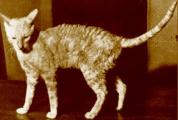 |  |  |
| History | |||||||||||||||
|
His owner, Mrs. Ennismore, decided he would make an unusual pet and took him to her veterinarian to be neutered. Fortunately the veterinarian recognized the kitten for what it was, a true mutation, and persuaded the owner to propagate this new breed. The help of a geneticist, Mr. A. C. Jude, was enlisted, and Kallibunker, the curly male, was bred back to his mother. Several curly kittens resulted. The new breed was named after a similar mutation among rabbits and it belonged to neither short hairs nor long hairs. Many of the kittens from these early experimental breedings were straight-haired, but this changed as soon as the number of Rex gene carrying cats increased. Following the laws of genetics, when Rex was bred to Rex all the kittens developed the characteristic curly fur. Developing a new breed is usually costly and time consuming, and Kallibunker's owner decided she could no longer afford to continue her breeding program. Among the cats she had put to sleep were the original Kallibunker and his dam. But fate seemed to intervene again in favor of the Rex breed. A descendant of Kallibunker, La Morna Cove, had been exported to the United States and would assure the continuance of the Cornish Rex Breed. In England, the survival of the breed depended basically upon two descendants of Kallibunker and would take a somewhat different development from that of the Rex in the United States. Although different in appearance from its stocky, heavy bodied domestic shorthair ancestors, the British Cornish Rex retains some of their features. Its head is rather round, with a short nose that shows a definite indentation below the eyes and with ears set wide apart into the side of the head. The fact that early breeders had bred Kallibunker and his son Poldhu to domestic shorthairs undoubtedly added to the heavier appearance of the breed in England. Poldhu was a very unusual cat. Usually tortoiseshell and blue-cream cats are female, and the occasional male of these colors is sterile. Poldhu, however, was a fertile blue-cream male, and after Kallibunker's untimely demise Poldhu sired a number of kittens. In order to find reasons for his genetic oddity, tissue samples were taken from Poldhu which resulted in his unplanned sterilization. It was now left to the only other surviving son of Kallibunker, Sham Pain Charlie, to carry on the future of the Rex breed in England. Relying heavily upon outcrosses to heavier breeds, the British breeders almost lost the distinctive Rex type until Mrs. Allison Ashford imported a great-great grandson of Kallibunker, Rio Vista Kismet, from Canada. Within four years Kismet had restored the Cornish Rex type, although even today there is a distinctive difference in type and head between Rex from different sides of the Atlantic. The first pair of Cornish Rex kittens brought to the United States was imported by Fran Blancheri of San Diego in 1957. Two kittens arrived: a blue female, La Morna Cove, and a red male, Pendennis Castle, who unfortunately died before he could sire any kittens. La Morna Cove, however, had been bred to her sire Poldhu before leaving England and two of her four kittens-Diamond Lil and Marmaduke-can be found as foundation stock in most pedigrees of American Cornish Rex. Marmaduke also helped establish the well known Dazz-ling line. Rex caught the interest of breeders and the general public, especially after Life featured a full page picture of a saucy kitten with curly hair and crinkly whiskers. Rex began to appear at cat shows and to achieve recognition in the cat fancy. In 1968-69 a black Cornish female, Grand Champion Rodell's Ravenesque, became the highest scoring shorthair female in the United States. Yet the Rex was still a rare breed, and breeders were limited to working with a few basic lines. | ||||||||||||||
| Cornelian Cornish Rex Cattery — Copyright Anna and Michel Kuzmenko © 2001-2025 | |||||||||||||||
 In Russian
In Russian